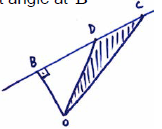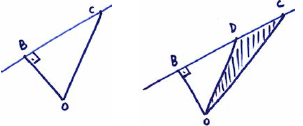| Marks available | 4 |
| Reference code | 13M.1.sl.TZ1.1 |
Question
Consider the vectors \(\boldsymbol{a} = \left( {\begin{array}{*{20}{c}}
2\\
{ – 3}
\end{array}} \right)\) and \(\boldsymbol{b} = \left( {\begin{array}{*{20}{c}}
1\\
4
\end{array}} \right)\) .
Let \(2\boldsymbol{a} + \boldsymbol{b} + \boldsymbol{c} = 0\) , where \(0\) is the zero vector.
(a) Find
(i) \(2\boldsymbol{a} + \boldsymbol{b}\) ;
(ii) \(\left| {2\boldsymbol{a} + \boldsymbol{b}} \right|\) .
Let \(2\boldsymbol{a} + \boldsymbol{b} + \boldsymbol{c} = 0\) , where \(0\) is the zero vector.
(b) Find \(\boldsymbol{c}\) .
Find
(i) \(2\boldsymbol{a} + \boldsymbol{b}\) ;
(ii) \(\left| {2\boldsymbol{a} + \boldsymbol{b}} \right|\) .
Find \(\boldsymbol{c}\) .
Answer/Explanation
Markscheme
(a) (i) \(2\boldsymbol{a} = \left( {\begin{array}{*{20}{c}}
4\\
{ – 6}
\end{array}} \right)\) (A1)
correct expression for \(2\boldsymbol{a} + \boldsymbol{b}\) A1 N2
eg \(\left( {\begin{array}{*{20}{c}}
5\\
{ – 2}
\end{array}} \right)\) , \((5, – 2)\) , \(5\boldsymbol{i} – 2\boldsymbol{j}\)
(ii) correct substitution into length formula (A1)
eg \(\sqrt {{5^2} + {2^2}} \) , \(\sqrt {{5^2} + – {2^2}} \)
\(\left| {2\boldsymbol{a} + \boldsymbol{b}} \right| = \sqrt {29} \) A1 N2
[4 marks]
(b) valid approach (M1)
eg \(\boldsymbol{c} = – (2\boldsymbol{a} + \boldsymbol{b})\) , \(5 + x = 0\) , \( – 2 + y = 0\)
\(\boldsymbol{c} = \left( {\begin{array}{*{20}{c}}
{ – 5}\\
2
\end{array}} \right)\) A1 N2
[2 marks]
(i) \(2\boldsymbol{a} = \left( {\begin{array}{*{20}{c}}
4\\
{ – 6}
\end{array}} \right)\) (A1)
correct expression for \(2\boldsymbol{a} + \boldsymbol{b}\) A1 N2
eg \(\left( {\begin{array}{*{20}{c}}
5\\
{ – 2}
\end{array}} \right)\) , \((5, – 2)\) , \(5\boldsymbol{i} – 2\boldsymbol{j}\)
(ii) correct substitution into length formula (A1)
eg \(\sqrt {{5^2} + {2^2}} \) , \(\sqrt {{5^2} + – {2^2}} \)
\(\left| {2\boldsymbol{a} + \boldsymbol{b}} \right| = \sqrt {29} \) A1 N2
[4 marks]
valid approach (M1)
eg \(\boldsymbol{c} = – (2\boldsymbol{a} + \boldsymbol{b})\) , \(5 + x = 0\) , \( – 2 + y = 0\)
\(\boldsymbol{c} = \left( {\begin{array}{*{20}{c}}
{ – 5}\\
2
\end{array}} \right)\) A1 N2
[2 marks]
Question
Point A has coordinates (−4, −12, 1) and point B has coordinates (2, −4, −4).
The line L passes through A and B.
Show that \(\mathop {{\text{AB}}}\limits^ \to = \left( \begin{gathered}
\,6 \hfill \\
\,8 \hfill \\
– 5 \hfill \\
\end{gathered} \right)\)
Find a vector equation for L.
Point C (k , 12 , −k) is on L. Show that k = 14.
Find \(\mathop {{\text{OB}}}\limits^ \to \, \bullet \mathop {{\text{AB}}}\limits^ \to \).
Write down the value of angle OBA.
Point D is also on L and has coordinates (8, 4, −9).
Find the area of triangle OCD.
Answer/Explanation
Markscheme
correct approach A1
eg \(\mathop {{\text{AO}}}\limits^ \to \,\, + \,\,\mathop {{\text{OB}}}\limits^ \to ,\,\,\,{\text{B}} – {\text{A}}\,{\text{, }}\,\left( \begin{gathered}
\,\,2 \hfill \\
– 4 \hfill \\
– 4 \hfill \\
\end{gathered} \right) – \left( \begin{gathered}
\, – 4 \hfill \\
– 12 \hfill \\
\,\,\,1 \hfill \\
\end{gathered} \right)\)
\(\mathop {{\text{AB}}}\limits^ \to = \left( \begin{gathered}
\,6 \hfill \\
\,8 \hfill \\
– 5 \hfill \\
\end{gathered} \right)\) AG N0
[1 mark]
any correct equation in the form r = a + tb (any parameter for t) A2 N2
where a is \(\left( \begin{gathered}
\,\,2 \hfill \\
– 4 \hfill \\
– 4 \hfill \\
\end{gathered} \right)\) or \(\left( \begin{gathered}
\, – 4 \hfill \\
– 12 \hfill \\
\,\,\,1 \hfill \\
\end{gathered} \right)\) and b is a scalar multiple of \(\left( \begin{gathered}
\,6 \hfill \\
\,8 \hfill \\
– 5 \hfill \\
\end{gathered} \right)\)
eg r \( = \left( \begin{gathered}
\, – 4 \hfill \\
– 12 \hfill \\
\,\,\,1 \hfill \\
\end{gathered} \right) + t\left( \begin{gathered}
\,6 \hfill \\
\,8 \hfill \\
– 5 \hfill \\
\end{gathered} \right),\,\,\left( {x,\,\,y,\,\,z} \right) = \left( {2,\,\, – 4,\,\, – 4} \right) + t\left( {6,\,\,8,\,\, – 5} \right),\) r \( = \left( \begin{gathered}
\, – 4 + 6t \hfill \\
– 12 + 8t \hfill \\
\,\,\,1 – 5t \hfill \\
\end{gathered} \right)\)
Note: Award A1 for the form a + tb, A1 for the form L = a + tb, A0 for the form r = b + ta.
[2 marks]
METHOD 1 (solving for t)
valid approach (M1)
eg \(\left( \begin{gathered}
\,k \hfill \\
12 \hfill \\
– k \hfill \\
\end{gathered} \right) = \left( \begin{gathered}
\,\,2 \hfill \\
– 4 \hfill \\
– 4 \hfill \\
\end{gathered} \right) + t\left( \begin{gathered}
\,6 \hfill \\
\,8 \hfill \\
– 5 \hfill \\
\end{gathered} \right),\,\,\left( \begin{gathered}
\,k \hfill \\
12 \hfill \\
– k \hfill \\
\end{gathered} \right) = \left( \begin{gathered}
\, – 4 \hfill \\
– 12 \hfill \\
\,\,\,1 \hfill \\
\end{gathered} \right) + t\left( \begin{gathered}
\,6 \hfill \\
\,8 \hfill \\
– 5 \hfill \\
\end{gathered} \right)\)
one correct equation A1
eg −4 + 8t = 12, −12 + 8t = 12
correct value for t (A1)
eg t = 2 or 3
correct substitution A1
eg 2 + 6(2), −4 + 6(3), −[1 + 3(−5)]
k = 14 AG N0
METHOD 2 (solving simultaneously)
valid approach (M1)
eg \(\left( \begin{gathered}
\,k \hfill \\
12 \hfill \\
– k \hfill \\
\end{gathered} \right) = \left( \begin{gathered}
\,\,2 \hfill \\
– 4 \hfill \\
– 4 \hfill \\
\end{gathered} \right) + t\left( \begin{gathered}
\,6 \hfill \\
\,8 \hfill \\
– 5 \hfill \\
\end{gathered} \right),\,\,\left( \begin{gathered}
\,k \hfill \\
12 \hfill \\
– k \hfill \\
\end{gathered} \right) = \left( \begin{gathered}
\, – 4 \hfill \\
– 12 \hfill \\
\,\,\,1 \hfill \\
\end{gathered} \right) + t\left( \begin{gathered}
\,6 \hfill \\
\,8 \hfill \\
– 5 \hfill \\
\end{gathered} \right)\)
two correct equations in A1
eg k = −4 + 6t, −k = 1 −5t
EITHER (eliminating k)
correct value for t (A1)
eg t = 2 or 3
correct substitution A1
eg 2 + 6(2), −4 + 6(3)
OR (eliminating t)
correct equation(s) (A1)
eg 5k + 20 = 30t and −6k − 6 = 30t, −k = 1 − 5\(\left( {\frac{{k + 4}}{6}} \right)\)
correct working clearly leading to k = 14 A1
eg −k + 14 = 0, −6k = 6 −5k − 20, 5k = −20 + 6(1 + k)
THEN
k = 14 AG N0
[4 marks]
correct substitution into scalar product A1
eg (2)(6) − (4)(8) − (4)(−5), 12 − 32 + 20
\(\mathop {{\text{OB}}}\limits^ \to \, \bullet \mathop {{\text{AB}}}\limits^ \to \) = 0 A1 N0
[2 marks]
\({\text{O}}\mathop {\text{B}}\limits^ \wedge {\text{A}} = \frac{\pi }{2},\,\,90^\circ \,\,\,\,\,\left( {{\text{accept}}\,\frac{{3\pi }}{2},\,\,270^\circ } \right)\,\) A1 N1
[1 marks]
METHOD 1 (\(\frac{1}{2}\) × height × CD)
recognizing that OB is altitude of triangle with base CD (seen anywhere) M1
eg \(\frac{1}{2} \times \left| {\mathop {{\text{OB}}}\limits^ \to } \right| \times \left| {\mathop {{\text{CD}}}\limits^ \to } \right|,\,\,{\text{OB}} \bot {\text{CD}},\) sketch showing right angle at B

\(\mathop {{\text{CD}}}\limits^ \to = \left( \begin{gathered}
– 6 \hfill \\
– 8 \hfill \\
\,5 \hfill \\
\end{gathered} \right)\) or \(\mathop {{\text{DC}}}\limits^ \to = \left( \begin{gathered}
\,6 \hfill \\
\,8 \hfill \\
– 5 \hfill \\
\end{gathered} \right)\) (seen anywhere) (A1)
correct magnitudes (seen anywhere) (A1)(A1)
\(\left| {\mathop {{\text{OB}}}\limits^ \to } \right| = \sqrt {{{\left( 2 \right)}^2} + {{\left( { – 4} \right)}^2} + {{\left( { – 4} \right)}^2}} = \left( {\sqrt {36} } \right)\)
\(\left| {\mathop {{\text{CD}}}\limits^ \to } \right| = \sqrt {{{\left( { – 6} \right)}^2} + {{\left( { – 8} \right)}^2} + {{\left( 5 \right)}^2}} = \left( {\sqrt {125} } \right)\)
correct substitution into \(\frac{1}{2}bh\) A1
eg \(\frac{1}{2} \times 6 \times \sqrt {125} \)
area \( = 3\sqrt {125} ,\,\,15\sqrt 5 \) A1 N3
METHOD 2 (subtracting triangles)
recognizing that OB is altitude of either ΔOBD or ΔOBC(seen anywhere) M1
eg \(\frac{1}{2} \times \left| {\mathop {{\text{OB}}}\limits^ \to } \right| \times \left| {\mathop {{\text{BD}}}\limits^ \to } \right|,\,\,{\text{OB}} \bot {\text{BC}},\) sketch of triangle showing right angle at B

one correct vector \(\mathop {{\text{BD}}}\limits^ \to \) or \(\mathop {{\text{DB}}}\limits^ \to \) or \(\mathop {{\text{BC}}}\limits^ \to \) or \(\mathop {{\text{CB}}}\limits^ \to \) (seen anywhere) (A1)
eg \(\mathop {{\text{BD}}}\limits^ \to = \left( \begin{gathered}
\,6 \hfill \\
\,8 \hfill \\
– 5 \hfill \\
\end{gathered} \right)\), \(\mathop {{\text{CB}}}\limits^ \to = \left( \begin{gathered}
– 12 \hfill \\
– 16 \hfill \\
\,10 \hfill \\
\end{gathered} \right)\)
\(\left| {\mathop {{\text{OB}}}\limits^ \to } \right| = \sqrt {{{\left( 2 \right)}^2} + {{\left( { – 4} \right)}^2} + {{\left( { – 4} \right)}^2}} = \left( {\sqrt {36} } \right)\) (seen anywhere) (A1)
one correct magnitude of a base (seen anywhere) (A1)
\(\left| {\mathop {{\text{BD}}}\limits^ \to } \right| = \sqrt {{{\left( 6 \right)}^2} + {{\left( 8 \right)}^2} + {{\left( 5 \right)}^2}} = \left( {\sqrt {125} } \right),\,\,\left| {\mathop {{\text{BC}}}\limits^ \to } \right| = \sqrt {144 + 256 + 100} = \left( {\sqrt {500} } \right)\)
correct working A1
eg \(\frac{1}{2} \times 6 \times \sqrt {500} – \frac{1}{2} \times 6 \times 5\sqrt 5 ,\,\,\frac{1}{2} \times 6 \times \sqrt {500} \times {\text{sin}}90 – \frac{1}{2} \times 6 \times 5\sqrt 5 \times {\text{sin}}90\)
area \( = 3\sqrt {125} ,\,\,15\sqrt 5 \) A1 N3
METHOD 3 (using \(\frac{1}{2}\)ab sin C with ΔOCD)
two correct side lengths (seen anywhere) (A1)(A1)
\(\left| {\mathop {{\text{OD}}}\limits^ \to } \right| = \sqrt {{{\left( 8 \right)}^2} + {{\left( 4 \right)}^2} + {{\left( { – 9} \right)}^2}} = \left( {\sqrt {161} } \right),\,\,\left| {\mathop {{\text{CD}}}\limits^ \to } \right| = \sqrt {{{\left( { – 6} \right)}^2} + {{\left( { – 8} \right)}^2} + {{\left( 5 \right)}^2}} = \left( {\sqrt {125} } \right),\,\) \(\left| {\mathop {{\text{OC}}}\limits^ \to } \right| = \sqrt {{{\left( {14} \right)}^2} + {{\left( {12} \right)}^2} + {{\left( { – 14} \right)}^2}} = \left( {\sqrt {536} } \right)\)
attempt to find cosine ratio (seen anywhere) M1
eg \(\frac{{536 – 286}}{{ – 2\sqrt {161} \sqrt {125} }},\,\,\frac{{{\text{OD}} \bullet {\text{DC}}}}{{\left| {OD} \right|\left| {DC} \right|}}\)
correct working for sine ratio A1
eg \(\frac{{{{\left( {125} \right)}^2}}}{{161 \times 125}} + {\text{si}}{{\text{n}}^2}\,D = 1\)
correct substitution into \(\frac{1}{2}ab\,\,{\text{sin}}\,C\) A1
eg \(0.5 \times \sqrt {161} \times \sqrt {125} \times \frac{6}{{\sqrt {161} }}\)
area \( = 3\sqrt {125} ,\,\,15\sqrt 5 \) A1 N3
[6 marks]

